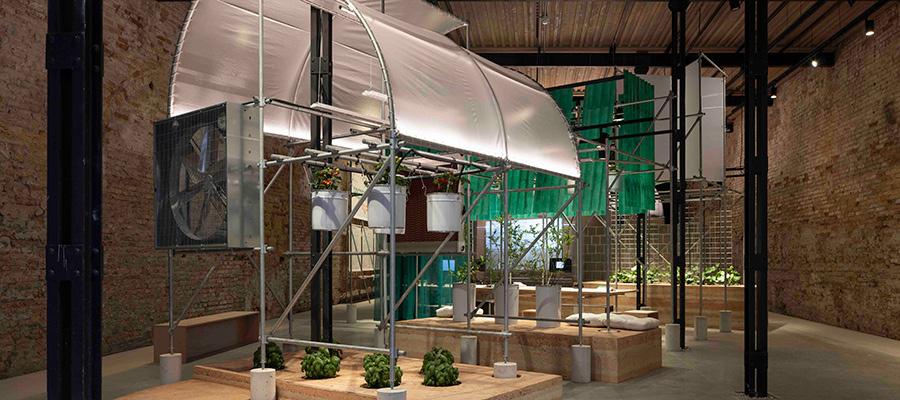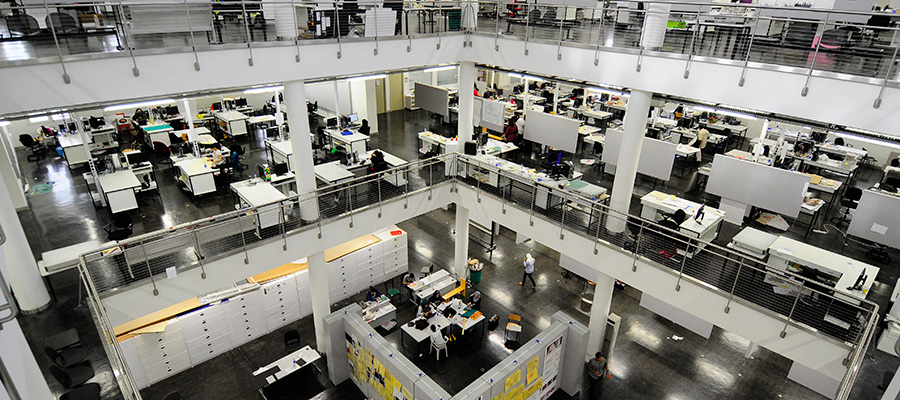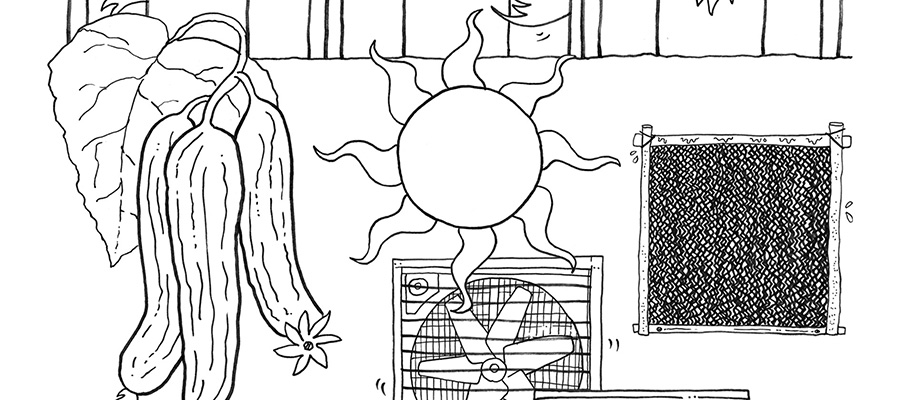- About
- Admissions
- Study at AUS
- Prospective Students
- Bachelor's Degrees
- Master's Degrees
- Doctoral Degrees
- Admission Publications
- International Students
- Contact Admissions
- Grants and Scholarships
- Sponsorship Liaison Services
- Testing Center
- New Undergraduate Student Guide
- Undergraduate Orientation
- New Graduate Student Guide
- Graduate Orientation
- File Completion
- Payment Guide
- Students with Disabilities
- Executive and Continuing Education
- Academics
- Life at AUS
- Research
- Publications
- Contact Us
- Apply Now
- .

AUS alumna Azza Aboualam curates UAE Pavilion at Venice Biennale with a vision for sustainable food future
What do locally grown blueberries, ancient greenhouses and the architecture of resilience have in common? According to Azza Aboualam, the Emirati architect and AUS architecture graduate behind this year’s UAE National Pavilion in Venice, they’re all part of a bigger story about the development of food security and sustainability in the UAE—a story that, surprisingly, begins in the UAE desert with 16th-century watchtowers built by the Portuguese to protect citrus groves in Fujairah.
The origins of Pressure Cooker: from curiosity to curatorial vision

Image Courtesy of National Pavilion UAE—the Venice Biennale. Photo: Daryll Borja of Seeing Things
Aboualam, a CAAD graduate who now works as an Assistant Professor at Zayed University’s College of Arts and Creative Enterprises and Co-Founder of Holesum Studio, came up with the idea for Pressure Cooker after her mother asked her an innocent question after she had returned home with locally grown blueberries: “Where do these desert blueberries come from?”
That question set off a long curatorial journey led by Aboualam and her team at Holesum Studio, an all-female local research and design-build team made up entirely of CAAD alumnae. The journey involved archival research, fieldwork across the UAE and sustained interdisciplinary collaboration among the different team members. Through conversations with local farmers, they discovered that people in the UAE have long been using different innovative methods to cool the environment, making it suitable for growing a variety of food products, and that even high-maintenance crops like coffee have been historically grown at the foothills of Jebel Hafeet.
Rethinking the greenhouse model for the UAE’s unique climate
As they delved deeper into the UAE’s agricultural history, one finding stood out: even today, most greenhouses in the UAE are not purpose-built for the local climate. Instead, they are adapted from designs intended for cooler European environments. This revelation became the central thread of Pressure Cooker, the immersive installation Aboualam and her team created for Intelligens. Natural. Artificial. Collective., the 19th International Architecture Exhibition in Venice.
“When thinking of titles, Pressure Cooker felt like the right choice as it works on multiple levels,” said Aboualam. “It’s a nod to food and its production, but also a metaphor for the greenhouse as a container where inputs and outputs mix to create something new. But we also liked that it speaks to the environmental pressures we face as a society today and the need for us to act now.”

Image Courtesy of National Pavilion UAE – La Biennale di Venezia. Photo by Ismail Noor of Seeing Things.
Set against the backdrop of the UAE’s harsh climate and limited natural resources, Pressure Cooker invites visitors to rethink how cities and communities grow, consume and share food. At first glance, the structure may resemble an ordinary greenhouse. But a closer look reveals a modular system, purposefully designed and engineered to respond to the UAE’s extreme environmental conditions.
“What makes our designs and assemblies different from others, is their slight shifts in architectural form. These help to mitigate high temperatures and minimize the number of days where internal temperature exceeds 30°C,” said Aboualam. “Thanks to simple changes in orientation, shape, external shade and even geothermal cooling, we completely re-imagined today’s greenhouse for our arid environment and made it truly relevant to our local context.”
Rooted in research: the CAAD connection

Aboualam said she brought much of what she learned at the College of Architecture, Art and Design (CAAD) to this project. “I had great mentors at CAAD who encouraged me to pursue my master’s degree and also research in architecture. So many of the people I interacted with at CAAD helped to broaden my understanding of how research can overlap and influence the built environment, something that’s clearly visible in this project,” she said. “Professor Kevin Mitchell, in particular, was a great mentor, and I’ll always be grateful for the advice and guidance he provided during my years at CAAD.”

Illustration by CAAD alumnus Khalid Mezaina, featured in Pressure Cooker—a cookbook-style publication that compiles the research underpinning the installation and accompanies the exhibition.
Shaping resilient futures: architecture as a tool for adaptive food systems
Each greenhouse assembly in the pavilion can be easily put together from a “kit of parts” including walls, roofs, floors and materials that can be altered based on site, climate and crop needs. They also blended traditional knowledge and modern tools, to provide just the right climate and temperatures for plants like basil, tomatoes and blueberries to grow.
“We wanted to highlight change and adaptation—not just in structure but in time,” explained Aboualam. “The pavilion won’t be the same every time you visit it. The plants change with the seasons, and each one has a different story. Cucumbers, for example, have deep historical roots. The first known greenhouse in Ancient Rome was built to grow them. They were also the first crops grown in early UAE greenhouses like the Saadiyat project. And of course, the blueberries are there as a nod to the original question that started it all.”
Beyond the physical installation, Pressure Cooker was also envisaged as an ongoing research platform that gathers data, tests systems and proposes replicable models for future design.
However, the team found that building full-scale prototypes came with its challenges. “We relied solely on hand tools, faced restrictions and often had to improvise building techniques inspired by our field observations,” recalled Aboualam. “Nevertheless, we found a way. We really hope these greenhouse kits might one day appear in schoolyards, community gardens and homes across the UAE and beyond.”
“Ultimately,” concluded Aboualam, “The pressure cooker is both a metaphor and a method. You combine ingredients and get something new. We hope this exhibition shows that anyone, anywhere, can grow food in a smarter, more accessible way.”
Pressure Cooker is on view at the 19th International Architecture Exhibition in Venice until November 23, 2025.
Learn more about CAAD’s innovative programs in architecture and design at www.aus.edu/caad
CAAD alumni team members:
Noor Nidal Hamdan: Senior Researcher and Design Build Coordinator @noor.nidal + @noors.arch
Nourhan Rahhal: Lab Assistant @nourhanr
Nujud Alhussain (graduation 2025): Publication Research Assistant @alhussainnjood
Sara Almahmoud: Research Assistant @saraalmahmoud
Khalid Mezaina: Illustrator @kmezaina

